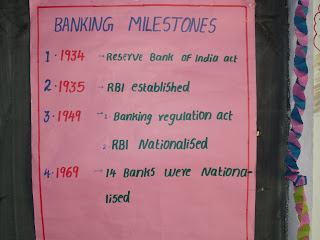Don't give in to social pressure and marketing tricks; pursue the career that you like best.
Though it is a slow turning tide, the mad rush for engineering and medical seats is declining. Many who were interested in the arts, humanities and commerce were forced into science streams once they completed Std X, or by then were irrecoverably convinced that the ultimate aim in their lives is to be an engineer or doctor.
Then came the MBA boom, do any U.G. course— Bio-technology, Computer Science, Mass Communication, Engineering—it doesn't really matter, but after that an MBA in ‘something' is sure to raise your ‘value in the job market'. These trends have made education a strategy to top the pay roll and the interests and aptitude of the students are not given a thought.
Not just a job
Passing the exams and getting a job in these fields might be easy, but many find it difficult to continue in the field. The increasing number of engineering, MBBS and MBA graduates, choosing professions like photography, writing, journalism and designing, is a proof for this.
“Basically the prestige and financial security attracts many to courses like engineering. Very few take it up with real interest and rarely do they enter jobs in their field of specialisation; most of them end up in the IT field. I was not interested in the job and so quit it after a year,” says an engineering graduate who took up journalism as his profession.
Those who decide to follow their passion and dare to tread the less travelled paths mostly go through a tough time convincing their parents, friends and relatives. Nandhana V., 25-year-old photographer and editor, says, “My father and older sister asked me to go for Chartered Accountancy because they thought it has good scope for a girl. You don't have to run around, but sit at a place and clients will come to you. So I joined CA. But listening to my lecturers talk about money all the time and, thinking about their lives, I decided that I don't want to become like them. I wanted to do something through which I could express my creativity and not just have money and accounts in my life. Actually what my dad decided is good in terms of comfort and economic security, but my heart was not in that. When I explained this and discontinued the course, my parents understood and supported me.”
Support from parents and friends is an important factor. Arun Kumar, a 23-year-old Assistant Film Editor, says, “I feel lucky to have such free-to-go parents. They let me go ahead with my decision to study Visual Communication and helped me in getting more information about the course. My brother also lent a helping hand. My friends in school thought that I had gone crazy. Few relatives still ask me, “We still don't get this... why did you chose this field?” Popular opinion and peer pressure also influence students to go for the most preferred courses. “One of my friends decided to do MBA because many of her friends were doing it and she thought it is cool and prestigious,” says Nanthana.
Wrong attitude
The general attitude towards pure science, arts and humanities is still not very encouraging. According to Nirmal Roy, a research scholar in Economics, there are many misconceptions about streams like economics, people are not aware of the opportunities, especially in rural areas. Even though many are interested in the field, for many reasons including pressure from parents, they opt for other courses. With a post graduation in economics you could find well-paid jobs like financial analysts, academicians, risk managers, research and data collection. If you get into research it will open up more opportunities. Many people don't know that there are places that offer fellowships in economics even at M.A level. But, now people prefer to get into jobs soon and no one has the patience to do P.G. and continue research.
Shashikala, a psychology teacher, says that not many people prefer this field, especially we could find very few boys taking up this course. “There is a misconception that the course is very simple and it's just common sense. Though it is not a lucrative field you could find a job as counsellor, teacher, or choose to train under a mentor and later open a clinic of your own. Many specialise in Psychometric study, a trend that is catching up now. Some people prefer to go for social work after this which will give them more job opportunities.”
Choose right
It is true that there are a number of innovative and unconventional courses available now, but a good understanding of the field and opportunities available is essential before opting for them.
There are many courses that are marketed as upcoming and lucrative, but after completing the courses the students are at a loss when they realise that there are very little opportunities in the field or the pay is way below their expectation.
Jinshad who has done a course in Lift Technology and Safety Engineering said that he had to resign because of financial problems. “Though, a few manage to find good jobs, there are very few options in the field and the pay is not as expected,” he said.
V.Uma who has completed a Diploma in Chemical Engineering says that very few girls had opted for the course, but she decided to pursue it. After completing the course she realised that most companies were not willing to take women candidates in the field and working in dyeing units and cement factories is hazardous to the health as well
V.S.Arun Kumar, Assistant Film editor
On field: It is an open field. Film making deals with lot of creativity, whereas film editing requires technical knowledge as well. There is no proper working time, sometimes we spend days sitting inside the editing suite. You have to put in a lot of hard work. And the worst deal is the pay; it will be very less in the beginning. You have to keep an open mind towards work. I worked for a movie, but wasn't paid a penny. But while joining itself they had told me not to expect any salary for a year or two. This is how the industry works. So you should make up your mind before entering this filed. Tough life guaranteed. People are slowly getting to know about opportunities in the field, the competition is high now and only the best can survive.
Where to study: There are many private institutes that offer editing courses. There are many film schools in our country like FTII Pune, L.V.Prasad Film and Television Academy, Chennai, Whistling Woods International and Tharamani MGR Film Institute, Chennai.
What I've learnt: One thing that I have learnt being in the filed is wherever you study, all that matters is your portfolio. Even if you don't go to any film school, but have a nice portfolio then you will be soon assisting somebody. The percentage of marks scored is the last thing they consider. Good communication skills, out of the box thinking and knowledge about the work are the basic requirements. Internship is also one very important factor in shaping your career. There are film editors, ad agencies, production houses, PR firms that offer internships.
Hari Narayanan, B.FA. Professional Photography, Brooks University, California
My decision: Photography has always been my passion. I was looking for good courses in photography, and Light and Life Academy(LLA), Ooty, looked interesting, but then they had only one year courses. I didn't want to learn just the basics but to do an intense course to master the art of photography, so, the next option was the Brooks Institute, where Iqbal Mohamed, Atul Kasbekar, Dilip Bhatia and many other famous photographers in India had gone to.
Where to study: The best course in India is LLA's one year photography programme. They have the finest range of experienced faculty.
Rare choices
Design: Graduate Diploma Programme in Design (GDPD) in National Institute of Design (http://www.nid.edu/) offered in:
Industrial Design: Product Design, Furniture & Interior Design, Ceramic & Glass Design
Communication Design: Graphic Design, Animation Film Design, Film & Video Communication, Exhibition (Spatial) Design.
Textile, Apparel And Lifestyle Design: Textile Design
Post-Graduate Diploma Programme In Design: 17 design programmes including Animation Film Design, Film & Video Communication and Transportation & Automobile Design.
Theatre: National School of Drama(http://nsd.gov.in/) : Three-year full-time Diploma Course for entrants intending to make theatre their profession.
Dr. Babasaheb Ambedkar Marathwada University, University of Mysore; Faculty of Fine Arts, Rabindra Bharati University;University of Rajasthan, Gandhi Nagar, Jaipur; Sambalpur University, Jyoti Vihar, Burla; Faculty of Performing Arts, M.S. University of Baroda, Vadodara; Pondicherry University, Kalapet, Pondicherry; Osmania University, Hyderabad; National School of Drama, Bahawalpur; Bhartendu Academy of Dramatic Arts (autonomous Training Institute, Deptt. of Culture) Satyajit Ray Film & Television Institute.
Archaeology and heritage: Master in Archaeology and Heritage Management, Master in Conservation, Preservation and Heritage Management and P. G. Diploma in Conservation, Preservation and Heritage Management at the Delhi Institute of Heritage Research and Management (http://dihrm.delhigovt.nic.in/).
Environmental Science : Pune University, Jawaharal Nehru University, Delhi; Anna University, Guindy; University of Madras, Chennai; Tamil Nadu GD Agricultural University, Coimbatore; Cochin University of Science and Technology, Kochi.
Msc. Wild Life Biology & Conservation: National Centre for Biological Science , G.K.V.K Campus, Hebbal.
Postgraduate program Astrophysics & Radio Astronomy: National Centre for Radio Astrophysics, Pune
Planning and Architecture: Courses — B.Arch, Bachelor of Planning, M.Arch, Master of Planning, Master of Building Engineering and Management, Master of Landscape Architectur



























